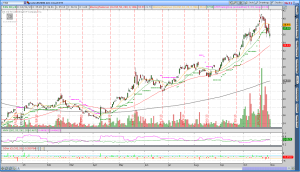Building a Diversified Trend Following Trading System with a Small Account
Trend Following Overview:
Trend Following trading generally makes use of a large number of underlyings (think markets) and trades all markets with a mechanical system. As I mentioned on this post, Donchian channel breakout systems can be used across numerous markets. There are countless other trend following systems that can be used to trade numerous markets including moving average systems, Bollinger band systems, and average true range pullback systems. Regardless of the trend following system, an emphasis is always placed on trading numerous, uncorrelated markets. Essentially, trend following traders want to diversify markets because it improves returns.
The Big Idea:
An extension of trading diversified markets with a trend following system is to trade multiple systems. For example, we could trade a trend following system that takes outright positions in markets, an options trading system that is trend following in nature, and a non-directional or mean reversion system. As a result, we will begin publishing some additional systems on Theta Trend: a monthly rotation system and a non-directional options trading system that focuses on iron condors. Expect posts in the near future to discuss the monthly rotation system and non-directional options trading, but I’ll give you a sneak peak below.
New System #1 Monthly Rotation System:

The monthly rotation system borrows heavily from the work of Mebane Faber in his book, The Ivy Portfolio. What we’re going to do slightly differently is look at all unleveraged, non-volatility ETF’s with an average daily volume of 50,000 shares and rank them on a monthly basis. Once we have a ranking, we will take positions in the top two and hold them for one month before reranking. For this month, the top two are TAN, the Guggenheim Solar ETF, and FAN, the First Trust Global Wind Energy ETF. More details on this system will be on the blog within the week.
New System #2 Non-Directional Options Trading
I will also add a Non-Directional Options Trading system to Theta Trend. The non-directional system will trade an Iron Condor every month in one of the following equity indexes: RUT, MNX, OEX, or SPX. I will generally focus on RUT iron condors, but may take a position in one of the other indexes if the volatility conditions are more favorable. Expect to see a write up on trading iron condors and the rules for adjustments within the next week.
System #3 – Theta Trend – Options Trend Following:
Finally, I’ll continue to post the Theta Trend system and look at it as part of a diversified trend following portfolio.
Constructing a Diversified Trend Following Portfolio – Equity Allocations:
While the diversified trend following strategy could be traded on any size account, I’ll use a small account size to show that this can be traded with a small account. The allocation below is based on a $10,000 account.
60% = $6,000 Trend Following System #1
This is going to be our monthly rotation system and, as a result, requires the largest amount of capital. I plan to take positions in the Top 2 performing ETFs, but this may be reduced to just the Top 1 depending on system performance and commission costs.
20% = $2,000 Trend Following System #2
This allocation will be used to trade the Theta Trend options trend following system. For simplicity, I’ll use the width of the spreads to determine risk. For example, a 4 point wide spread will be considered $400 of the risk allocation and a 5 point wide spread will be treated as having $500 worth of risk. As a result, we should be able to take 4-5 positions every month.
10% = $1,000 Non-Direction System #1
The risk allocation for non-directional trading will be measured in the same way as the Theta Trend risk. For example, a RUT iron condor that is 10 points wide (our preferred width) will take up the full risk amount. Essentially, you can expect to see one iron condor every month as part of the diversified portfolio.
10% = $1,000 Cash
The iron condor positions will require adjustments at various times so some portion of the account needs to be kept in cash. The 10% cash allocation is probably larger than necessary, but will ensure that cash is available without pushed the account into margin.
Recap:
Building a diversified trend following portfolio is our way of improving returns and spreading out risk. This is our way of trading a total trend following portfolio in a systematic manner. If you would trade a different system or use different allocations, feel free to let me know in the comments below. Also, don’t forget to click above and share this on your favorite social media platform.
4 thoughts on “Building a Diversified Trend Following Trading System with a Small Account”
Comments are closed.